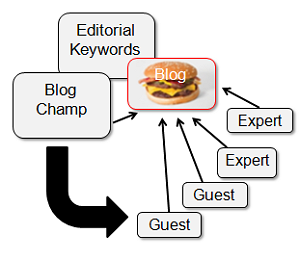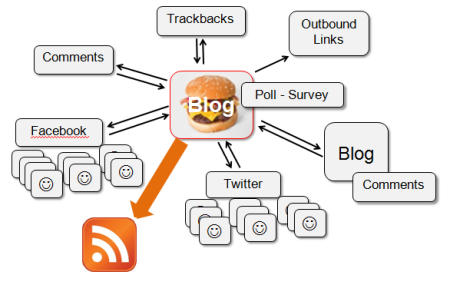 Yesterday I posted “3 Reasons Why Blog SEO Fails” to help readers avoid the pitfalls of starting a business or corporate blog purely for SEO reasons only to end up wasting time and energy. Without proper planning, oversight and passion for the topic, blogs implemented purely for SEO objectives are doomed to fail. Additionally, social media referrals and recommendations are becoming a notable competitor to search traffic which can place SEO as a secondary promotional effort in some situations.
Yesterday I posted “3 Reasons Why Blog SEO Fails” to help readers avoid the pitfalls of starting a business or corporate blog purely for SEO reasons only to end up wasting time and energy. Without proper planning, oversight and passion for the topic, blogs implemented purely for SEO objectives are doomed to fail. Additionally, social media referrals and recommendations are becoming a notable competitor to search traffic which can place SEO as a secondary promotional effort in some situations.
Here are five tips for successful business blog optimization benefits in the long run:
1. Find a practical purpose for starting a blog. There are many reasons why companies would benefit from starting and publishing a blog. Some might use blog software as a content management system for an online newsroom or to archive newsletters to the web.
Other blog applications include: aggregating industry news, publishing ongoing product development information, improving customer relations, building thought leadership or improving onlne marketing and sales. Identifying a specific business goal that can be facilitated by the creation, publishing and promotion of blog content should be the first step.
Whether the goal is to better connect with existing customers and reduce support costs or to attract more media coverage to improve indusry reputation, there should be a specific business goal for the blog. SEO can be used to further that objective through improved search visibility.

2. Optimize templates initially and content on an ongoing basis. As dynamically generated web sites, blogs take information stored to a database and push that information through templates which generate the web pages or blog posts we read in a web browser.
Optimization of a blog at the template level will pass on benefits to all pages of the blog. For example, the use of blog post titles in the URLs rather than an id number. Or posting distinct title tags separate from the on page titles.
Blog content optimization means leveraging a keyword glossary to allow company bloggers to make informed choices about what phrases to use in titles, categories, body copy, anchor text links, tags, image alt text and others. This is an activity that often gets diluted if there isn’t a quality assurance effort, oversight editorially or persistent attention to SEO.
3. Plan editorial and source content. Unlike traditional publications, blogs do not typically have editorial calendars but why not? Use categories as an indication for the topics the blog should be posting about. Category keywords should support the business goals defined in the blog’s objectives.

Here are some simple steps for managing blog content, long term: Create a keyword glossary, much like you would for a website SEO project. Identify an editorial guide as well as post types and key topics. Assign a blog champion, someone that “owns” the success/failure of the blog. The blog champion will provide content and editorial oversight as well as recruit other contributors.
The blog champion performs another important function, feedback to the contributors. This goes beyond a simple “thank you” but may also include reporting on the number of comments on posts contributed, inbound links, increases in RSS subscribers and mentions of the blog post on other blogs. Providing individual as well as overall feedback to contributors helps them see what impact their efforts are making.
4. Socialize.
Blogs are a big part of what makes up social media, so it’s important that bloggers are social for a successful blogging effort. A few of the ways blogs can be social include:

- Comments – be sure to respond to commments on your blog quickly
- Links out to other blogs – Blog software like WordPress will notify the blog owner when others link in. Besides providing readers a link to a useful resource, getting the attention of a prominent and/or influential blogger by linking to them can result in being mentioned in a post with a link back.
- Trackbacks are the mutual link exchange that can happen when one blog links to another.
- Widgets and polls/surveys can be effective social tools for a blog, because they allow interaction and direct feedback.
- Reading and commenting on other blogs is very important for the success of a blog to connect with other influential information sources on your topic. Bloggers are also more keen to network with each other than they are with non-bloggers.
- Social networking tools like Facebook and communication tools like Twitter can be effectively used to socialize a blog by crowdsourcing the network for content as well as a channel for promoting new content. Recognizing contributors and aggregating resources is a win for everyone.
5. Measure and promote blog success – In order for a blogging effort of any kind to be successful, there needs to be an objective. Ideally an objective that helps reach a particular business goal. Once that goal for the blog is indentified, it’s important to take a benchmark measurement to understand where you are starting from.
Monitoring mentions of the blog in real time with basic tools like Google Alerts and TweetBeep can be effective discovery tools in finding fans of your blog. Robust monitoring tools such as BuzzLogic, Techrigy or Radian6 can be helpful for monitoring multiple social media channels.
Discovering trending of keywords within blogs or services like Twitter can present opportunistic content marketing situations. If a term is observed as becoming increasingly popular, the blog conducting the monitoring can choose to create more content and engage in link building to encourage high ranking for those terms.
Besides monitoring, it’s important measure the specific goals set out for the blog using web analytics.
As the data and success metrics are collected, be sure to package the information for reporting upstream in the organization. ROI on social media marketing efforts, including blogging, can be challenging. However, if the blog is attracting any kind of popular keyword phrase traffic from organic search, it can be compared to the costs to achieve those same positions and visitors with pay per click. The resulting comparison should offer an estimated a dollar value of organic search traffic.
Another valuation method for blogs is when the blog facilitates media coverage, including other blogs. If a company hires a public relations firm to conduct blogger and media relations, it costs money and that investment can be boiled down to a value per pickup. If publishing content on the blog results in being cited, linked or mentioned by a popular blog or publication, it should be tracked and a dollar value assigned. Such ROI associations from blogging can vary depending on the purpose of the blog ranging from lowering customer service costs to saving recruiter fees for attracting new employees.
The other type of reporting that is important for the longevity of a blog and the ongoing optimization effort is feedback to those that make it happen. A blog SEO effort cannot be successful if there is no one to write posts. Therefore, it’s important to keep contributors motivated by keeping them informed on the progress of the blog in reaching overall goals as well as the effect ofo their individual contributions.
Wrap up:
For a successful business blogging effort that leverages search engine optimization, it’s important that the blog serves a functional purpose intented to help the business reach a particular goal. SEO is involved in order to extend the reach and “discoverability” of the blog.
Blog optimization is both a one time event with the templates but is also an ongoing process involving keyword glossaries that help determine post level keyword usage, internal anchor text and off site anchor text. Running out of ideas and people to contribute to the blog can mean certain death, so be creative with content sourcing and formats. Listen to what blog readers respond to and give feedback on to guide editorial.
Blog software offers many social features. Use them! Grow a network that leverages the blog as resource and as a way to recognize contributors. Monitor real time content opportunities as well as blog analytics so you can offer the kind of feedback that motivates continued contributions both from the C-Suite in the form of funding and from the B-Suite in the form of content and comments.


